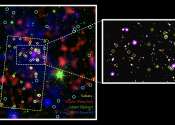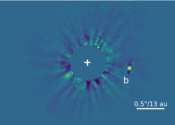Scientists have spotted the farthest galaxy ever
An international team of astronomers, including researchers at the Center for Astrophysics | Harvard & Smithsonian, has spotted the most distant astronomical object ever: a galaxy.

An international team of astronomers, including researchers at the Center for Astrophysics | Harvard & Smithsonian, has spotted the most distant astronomical object ever: a galaxy.
Astronomy
Apr 7, 2022
89
1749

NASA's Hubble Space Telescope has directly photographed evidence of a Jupiter-like protoplanet forming through what researchers describe as an "intense and violent process." This discovery supports a long-debated theory for ...
Astronomy
Apr 4, 2022
4
904

An international team of astronomers has reported the discovery of a structure thought to be a "protocluster" of galaxies on its way to developing into a galaxy supercluster. Located 11 billion light-years from Earth, the ...
Astronomy
Oct 27, 2021
14
408

A group of astronomers from the Astrobiology Center, the National Astronomical Observatory of Japan, the University of Tokyo, and other institutes, discovered two rocky super-Earth exoplanets lacking thick primordial atmospheres ...
Astronomy
Sep 27, 2021
0
3656

A new study of lithium production in a classical nova found a production rate of only a couple of percent that seen in other examples. This shows that there is a large diversity within classical novae and implies that nova ...
Astronomy
Jul 7, 2021
2
18

An international research team analyzed a database of more than 1000 supernova explosions and found that models for the expansion of the Universe best match the data when a new time dependent variation is introduced. If proven ...
Astronomy
May 14, 2021
29
563

On December 10, 2020 (Hawai'i Standard Time), the Subaru Telescope imaged the small asteroid 1998 KY26, the target of Hayabusa2's extended mission. The positional data for 1998 KY26 collected during the observations will ...
Space Exploration
Dec 18, 2020
0
241

Astronomers using two Maunakea Observatories—Subaru Telescope and W. M. Keck Observatory—have discovered a key benchmark brown dwarf orbiting a sun-like star just 86 light-years from Earth that provides a key reference ...
Astronomy
Dec 14, 2020
0
349

Astronomers have applied artificial intelligence (AI) to ultra-wide field-of-view images of the distant Universe captured by the Subaru Telescope, and have achieved a very high accuracy for finding and classifying spiral ...
Astronomy
Aug 11, 2020
0
333

Using the Subaru Telescope, astronomers have identified two new dust-reddened (red) quasars at high redshifts. The finding, detailed in a paper published July 16 on the arXiv pre-print server, could improve the understanding ...